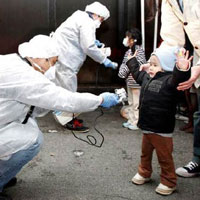But Philippines far away from Japan’s soaring radiation; search widened for 31 Filipinos
MANILA – Hoax text messages about nuclear fallout having allegedly reached Philippine skies triggered panic in the highly populated Metro Manila as a result of the strong earthquake in Japan which caused explosions to its nuclear reactors.

But the fears of Metro Manilans were immediately allayed by President Benigno S. Aquino III and officials, including the National Disaster Risk Reduction and Management Council (NDRRMC), the Philippine Nuclear Research Institute (PNRI) and the Philippine Atmospheric, Geophysical and Astronomical Services Administration (PAGASA), which assured that there was nothing to worry about possible adverse effects of the nuclear meltdown in Japan.
Health Secretary Enrique Ona and Science and Technology Secretary Mario Montejo said it was unlikely radiation from the Japan nuclear reactors would reach the Philippines. The two Cabinet officials assured that contingency measures have been adopted and that the government was ready to response to any emergency.
This developed as 31 of about 300,000 Filipinos living in Japan have been reported missing and efforts have been exerted to locate them. Earlier, 30 missing Filipino seamen were rescued and were on the way back to Manila.
At press time, lack of food and water for victims gripped wide areas in Japan even as power and communications lines have remained cut off in many areas while restored in other areas affected by the big quake and tsunami.
The death toll in the disaster may well be more than 10,000 as details of the destruction surfaced.
On order of President Aquino, the government is continuously monitoring the situation in Japan, particularly the whereabouts of Filipinos there and the effects of the quake to Japan’s nuclear facilities, said Deputy Presidential Spokesperson Abegail Valte.
The Senate committees on environment and climate change, meanwhile, has scheduled a hearing on the status of the risk reduction and management plans of national and local government agencies in the wake of the Japan disaster, said Sen. Juan Miguel Zubiri.
The probe came in the wake of a warning from noted architect Felino Palafox that the Philippines was not ready for a major quake as it failed to act on a study and recommendation by experts, including Japan, in 2004 for the country to undertake risk reduction plans.
Palafox said Metro Manila lacked rescue and evacuation facilities to cope with such a major disaster even as experts warned that the Marikina fault line was approaching its “active phases.”
President Aquino wants regular updates on the Japan situation to ensure the safety of Filipinos and make sure that a nuclear meltdown would not affect the Philippines, Valte said.
Health Secretary Enrique Ona said in a press briefing attended by President Aquino and Cabinet members that the public need not panic about suffering from radiation exposure resulting from the damages to a Fukushima nuclear power plant in Japan.
“The Philippines is safe from radiation,” Ona said, as the pattern of the wind indicated that it was towards north and away from the Philippines.
“It’s a point of concern for the President because it concerns the health of the country which is involved. It’s a point of concern which is why he asked for regular updates on the matter given that it’s not only one incident… I believe there are six reactors that are in Fukushima,” Valte said. “So he wants regular updates on how these will affect us in case there will be more problems.”
The World Health Organization (WHO) which maintains its Asia Pacific office in Manila stressed that there is minimal public health risk arising from radioactive leaks from Japan’s damaged nuclear reactors.
“From what we know at the moment on the radiation levels, the public health risk is minimal for Japan,” said Gregory Hartl, WHO spokesman.
Valte said the government has contingency measures in place should the situation worsens.
She noted, however, that the primary concern of the government is on the safety of Filipinos who are still in Japan and the monitoring of the situation.
Valte urged the public to refrain from disseminating false information on the situation in Japan.
“We want to tell people giving false informations that these things have no place in these kind of situation because it is already sensitive,” she said.
A magnitude 8.9 earthquake hit Japan last Friday, triggering a 30-foot tsunami that surged across its northeast region, killing about 10,000 people and destroying buildings, airports, roads, ships and other infrastructures and properties. The intensity of the temblor was later elevated to number a record 9.
Japan is racing to prevent a nuclear disaster, as explosions rocked overheating reactors after cooling systems at three reactors failed following Friday’s big quake. Another reactor exploded on Tuesday, authorities said.
Thousands, including Filipinos, have been evacuated following the explosion and leak from the facility’s No. 1 reactor in Fukushima, 240 kilometers north of Tokyo, where there is believed to have been a partial meltdown of the fuel rods.
NDRRMC Executive Director Benito Ramos said the NDRRMC will launch the National Radiological Emergency Preparedness and Response Plan (RADPLAN) which covers nuclear emergencies.



 ShareThis
ShareThis